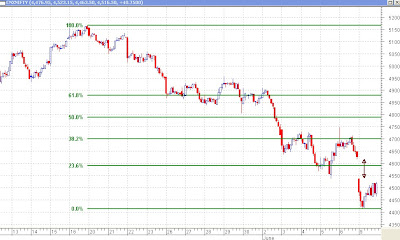This also means that our Elliott Wave counts of 1,2,3,4,5 of corrective wave C, as mentioned in one of the previous posts has gone wrong. It also means that the fifth wave has not ended as yet. This means that the fifth wave is also an extended wave. We don’t know how long it will be. What we know is that it cannot be longer than the third wave. The third wave started at 5167.40 on May 16, 2008 and ended at 4369.80 (assuming that to be the end of wave 3) on June 10, 2008, thus measuring 797.60 points. The fifth wave started on June 18, 2008 at 4679.75. This means that the wave five cannot go below 3882.15 in any case. If it does then it means that our wave counting is wrong again and that we may still be in wave 3 of major corrective wave C.
 For tomorrow we have support between 3970 and 4000, as was seen in the chart shown yesterday. According to the Elliott Wave Counts (assuming them to be correct), we do not expect the final low for the Nifty below 3882.15. So, we may be looking at support between 3882 and 4000. Shown above is the daily chart of Nifty with Elliott Wave Counts and with the Bollinger Bands. The close of the Nifty today was below the lower band, and as mentioned in an earlier post, it means that if the close does not come back within the band tomorrow then we may be looking at more downside. It effectively means that if it breaks 4000 tomorrow then we may be looking at a target near 3882.
For tomorrow we have support between 3970 and 4000, as was seen in the chart shown yesterday. According to the Elliott Wave Counts (assuming them to be correct), we do not expect the final low for the Nifty below 3882.15. So, we may be looking at support between 3882 and 4000. Shown above is the daily chart of Nifty with Elliott Wave Counts and with the Bollinger Bands. The close of the Nifty today was below the lower band, and as mentioned in an earlier post, it means that if the close does not come back within the band tomorrow then we may be looking at more downside. It effectively means that if it breaks 4000 tomorrow then we may be looking at a target near 3882.The political situation also worsened (or improved??) today. The Prime Minister has decided to go and attend the G8 summit. The Left has taken it as a signal that the Government has decided to go ahead with the nuclear deal and reiterated, once again, that it would withdraw support if it did so. To make matters worse, the Prime Minister said that “there has been nothing new with the Left’s stand”. The political analysts view his confidence as a confirmation that the Government is confident of getting the support of the Samajwadi Party (SP) in case the Left withdraws support. With the UPA tally at 225 and adding 39 as the SP support the UPA still falls 8 short of the magic number of 272 to get a majority. However, getting the support of 8 more may not be too difficult a problem for the government. In case it does get the support, it would mean that the nuclear deal would go through and the government also will not fall. With the Left out of the way, the Government actually may be able to take some positive decisions (not saying that it has too much of time to do that since elections are due in May next year). That would be an ideal situation for the markets to begin a new bull market.
But inflation would still remain a concern and the market may probably be looking at a stabilization in the inflation rates before starting to go up again. With the world commodity prices still increasing and crude on the rise again, and the effect of the petrol price hike last month trickling down to other industries, the inflation figures are likely to become worse at least for another month or two, before stabilizing.
Please do subscribe to my posts, so that all posts are delivered free to your inbox and you don't miss any useful analysis of the markets in the future.
Happy Investing!!!


























